102–103 High Street, Merthyr Tydfil, CF47 8AP
A plaque on the library wall, facing this pub, describes Dic Penderyn as a martyr of the working class, having been publicly hanged for his support of the famous 1831 Merthyr Rising.
A print and text about Richard Trevithick.
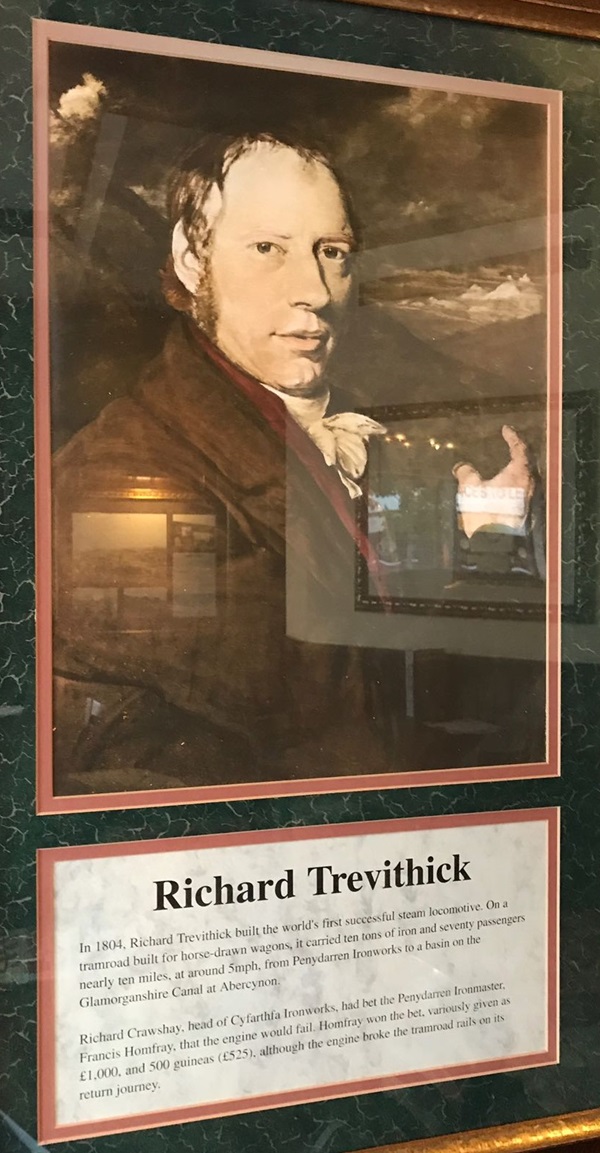
The text reads: In 1804, Richard Trevithick built the world’s first successful steam locomotive. On a tramroad built for horse-drawn wagons, it carried ten tons of iron and seventy passengers nearly ten miles, at around 5mph, from Penydarren Ironworks to a basin on the Glamorganshire Canal at Abercynon.
Prints and text about the early days of Methyr Tydfil.
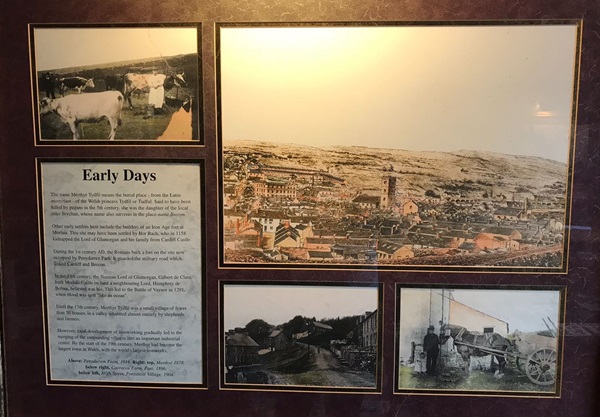
The text reads: The name Merthyr Tydfil means the burial place – from the Latin martyrium – of the Welsh princess Tydfil or Tudful. Said to have been killed by pagans in the 5th century, she was the daughter of the local ruler Brychan, whose name also survives in the place-name Brecon.
Other early settlers here include the builders of an Iron Age fort at Morlais. This site may have been settled by Ifor Bach, who in 1158 kidnapped the Lord of Glamorgan and his family from Cardiff Castle.
During the 1st century AD, the Romans built a fort on the site now occupied by Penydarren Park. It guarded the military road which linked Cardiff and Brecon.
In the 13th century, the Norman Lord of Glamorgan, Gilbert de Clare, built Morlais Castle on land a neighbouring Lord, Humphrey de Bohun, believed was his. This led to the Battle of Vaynor in 1291, when blood was spilt “like an ocean”.
Until the 17th century, Merthyr Tydfil was a small village of fewer than 50 houses, in a valley inhabited almost entirely by shepherds and farmers.
However, local development of ironworking gradually led to the merging of the surrounding villages into an important industrial centre. By the start of the 19th century, Merthyr had become the largest town in Wales, with the world’s largest ironworks.
Above: Penydarren Farm, 1914
Right, top: Merthyr 1878
Below right: Caeracca Farm, Pant. 1896
Below left: High Street, Pontsticill Village, 1904.
Prints and text about William Ewart Berry.
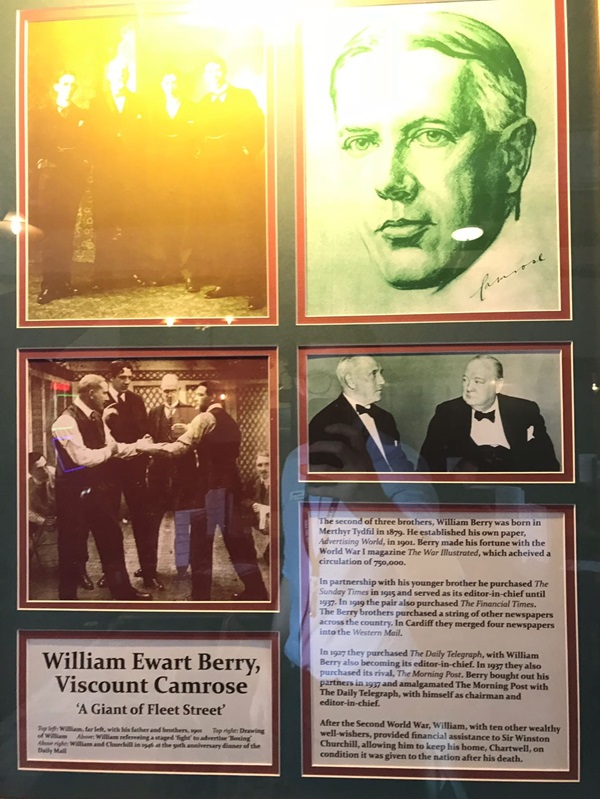
The text reads: The second of three brothers, William Berry was born in Merthyr Tydfil in 1879. He established his own paper, Advertising World, in 1901. Berry made his fortune with the World War I magazine The War Illustrated, which achieved a circulation of 750,000.
In partnership with his younger brother he purchased The Sunday Times in 1915 and served as its editor-in-chief until 1937. In 1919 the pair also purchased The Financial Times. The Berry brothers purchased a string of other newspapers across the country. In Cardiff they merged four newspapers into the Western Mail.
In 1927 they purchased The Daily Telegraph, with William Berry also becoming its editor-in-chief. In 1937 they also purchased its rival, The Morning Post. Berry brought out his partners in 1937 and amalgamated The Morning Post with The Daily Telegraph, with himself as chairman and editor-in-chief.
After the Second World War, William, with ten other wealthy well-wishers, provided financial assistance to Sir Winston Churchill, allowing him to keep his home, Chartwell, on condition it was given to the nation after his death.
Top left: William, far left, with his father and brothers, 1901
Top right: Drawing of William
Above: William refereeing a staged ‘fight’ to advertise ‘Boxing’
Above right: William and Churchill in 1946 at the 50th anniversary dinner of the Daily Mail.
Prints and text about Josiah John Guest.
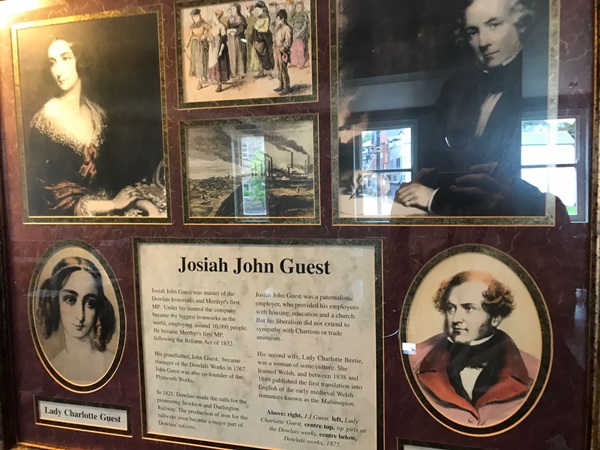
The text reads: Josiah John Guest was master of the Dowlais Ironworks and Merthyr’s first MP. Under his control the company became the biggest ironworks in the world, employing around 10,000 people. He became Merthyr’s first MP, following the Reform Act of 1832.
His grandfather, John Guest, became manager of the Dowlais Works in 1767. John Guest was also co-founder of the Plymouth Works.
In 1821, Dowlais made the rails for the pioneering Stockton and Darlington Railway. The production of iron for the railways soon became a major part of Dowlais’ success.
Josiah John Guest was a paternalistic employer, who provided his employees with housing, education, and a church. But his liberalism did not extend to sympathy with Chartism or trade unionism.
His second wife, Lady Charlotte Bertie, was a woman of some culture. She learned Welsh, and between 1838 and 1849 published the first translation into English of the early medieval Welsh romances known as the Mabinogion.
Above right: JJ Guest
Left: Lady Charlotte Guest
Centre top: Tip girls at the Dowlais works
Centre below: Dowlais works, 1875.
Illustrations and text about Cyfarthfa.
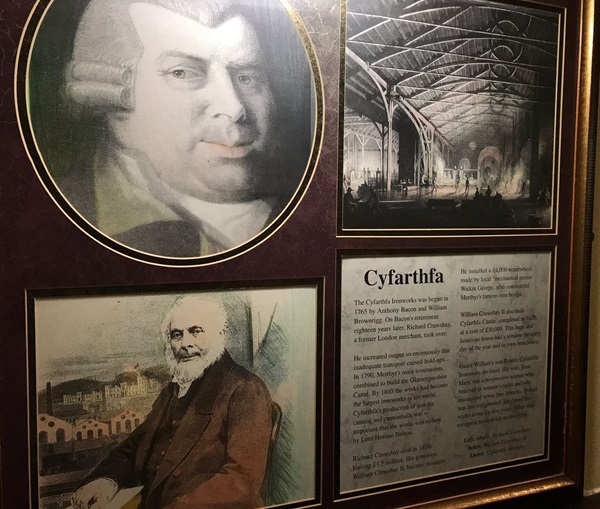
The text reads: The Cyfarthfa Ironworks was begun in 1765 by Anthony Bacon and William Brownrigg. On Bacon’s retirement eighteen years later, Richard Crawshay, a former London merchant, took over.
He increased output so enormously that inadequate transport caused hold-ups. In 1790, Merthyr’s main ironmasters combined to build the Glamorganshire Canal. By 1803 the works had become the largest ironworks in the world. Cyfarthfa’s production of iron for cannon and cannonballs was so important that the works was visited by Lord Horatio Nelson.
Richard Crawshay died in 1810, leaving £1.5 million. His grandson, William Crawshay II, became manager.
He installed a £4,000 waterwheel made by local “mechanical genius” Watkin George, who constructed Merthyr’s famous iron bridge.
William Crawshay II also built Cyfarthfa Castle, completed in 1825, at a cost of £30,000. This huge and luxurious house had a window for every day of the year and its own brewhouse.
Under William’s son Robert, Cyfarthfa Ironworks declined. His wife, Rose Mary, was a progressive woman who believed in women’s rights and who maintained seven free libraries. Robert was less enlightened. He closed the works down for five years, rather than recognise trade union membership.
Left, above: Richard Crawshay
Below: William Crawshay II
Above: Cyfarthfa at night.
Prints and text about civic pride.
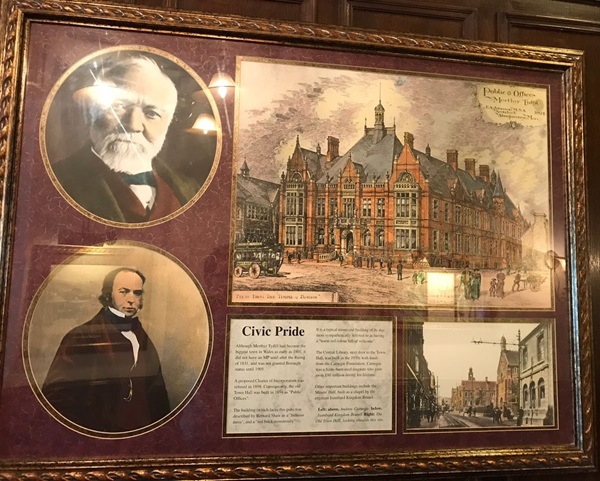
The text reads: Although Merthyr Tydfil had become the biggest town in Wales as early as 1801, it did not have an MP until after the Rising of 1831, and was not granted Borough status until 1905.
A proposed Charter of Incorporation was refused in 1898. Consequently, the old Town Hall was built in 1894 as “Public Offices”.
The building (which faces this pub) was described by Bernard Shaw as a “hideous mess” and a “red brick monstrosity”.
It is a typical municipal building of its day, more sympathetically referred to as having a “warm red colour full of welcome”.
The Central Library, next door to the Town Hall, was built in the 1930s with funds from the Carnegie Foundation. Carnegie was a Scots-born steel magnate who gave away £80 million during his lifetime.
Other important buildings include the Miners’ Hall, built as a chapel by the engineer Isambard Kingdom Brunel.
Left, above: Andrew Carnegie
Below: Isambard Kingdom Brunel
Right: The Old Town Hall, looking towards this site.
Prints and text about Joseph Parry.
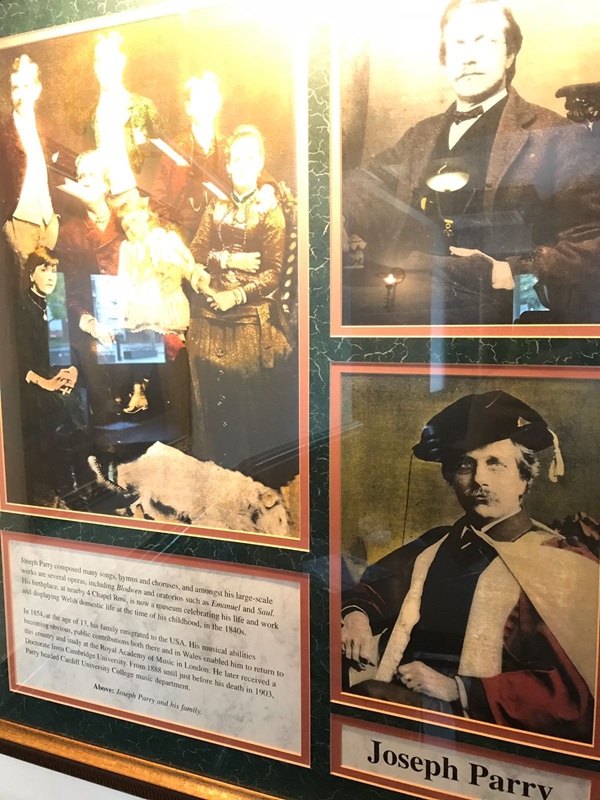
The text reads: Joseph Parry composed many songs, hymns and choruses, and amongst his large-scale works are several operas, including Blodwen and oratorios such as Emanuel and Saul. His birthplace, at nearby 4 Chapel Row, is now a museum celebrating his life and work and displaying Welsh domestic life at the time of his childhood, in the 1840s.
In 1854, at the age of 13, his family emigrated to the USA. His musical abilities becoming obvious, public contributions both there and in Wales enabled him to return to this country and study at the Royal Academy of Music in London. He later received a Doctorate from Cambridge University. From 1888 until just before his death in 1903, Parry headed Cardiff University College music department.
Above: Joseph Parry and his family.
A photograph of Pontmorlais, Merthyr Tydfil, c1905.
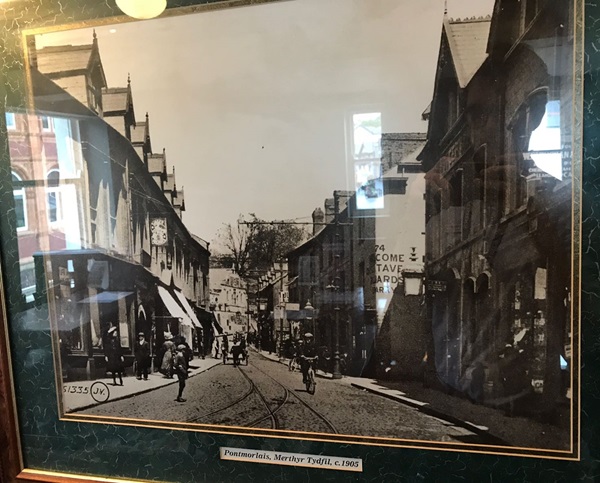
An illustration of Merthyr Tydfil High Street.
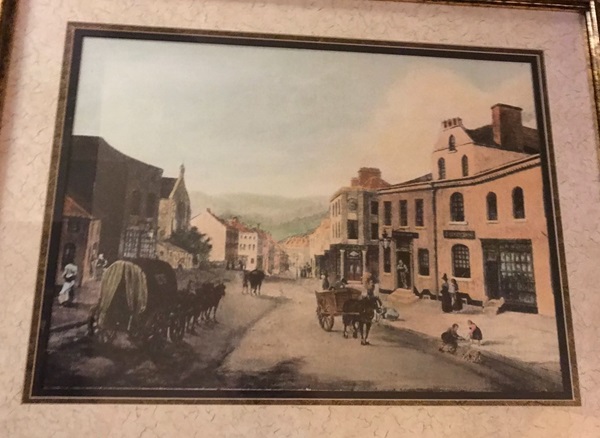
A photograph of High Street Central, Merthyr Tydfil, c1905.
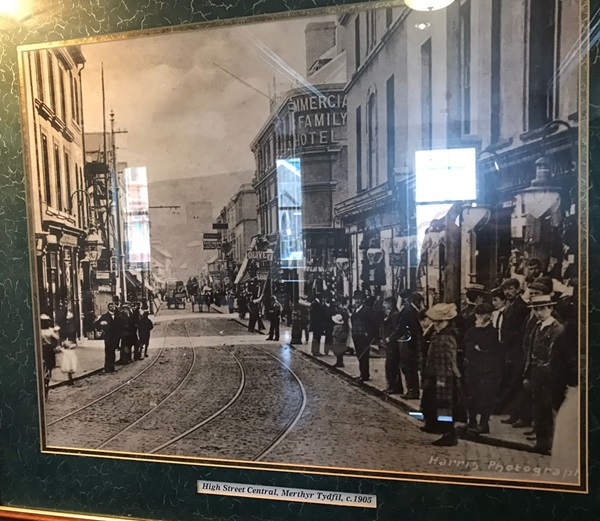
A photograph of Theatre Royal and Promenade, Merthyr Tydfil, c1909.
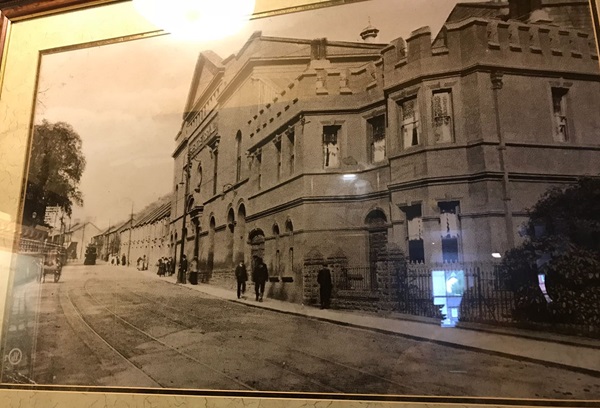
External photograph of the building – main entrance.
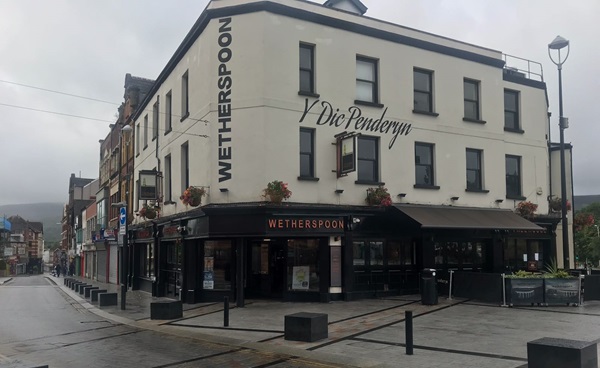
If you have information on the history of this pub, then we’d like you to share it with us. Please e-mail all information to: pubhistories@jdwetherspoon.co.uk